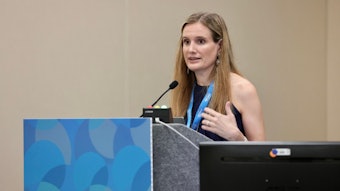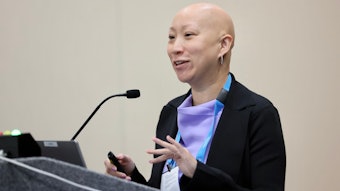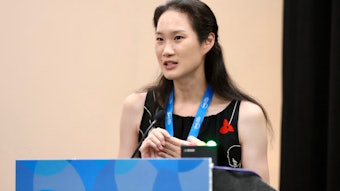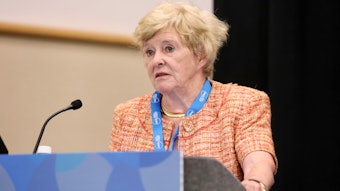How to love the skin we’re all in
Keynote speaker expounds on our understanding of the evolution of skin and the genetics of skin pigmentation.

Nina Jablonski, PhD, has traveled across the globe performing research and presenting her findings. On Thursday, Dr. Jablonski shared a cerebral, time-traveling expedition to uncover the past, make sense of the present, and move into the future with the AAD and delivered “K001 – Keynote Speaker: Why Should Dermatologists Pay Attention to the Evolution of Skin and Skin Pigmentation and the History of Color-Based Race Classification?” Dr. Jablonski, an esteemed biological anthropologist, paleobiologist, and storyteller, deftly unpacked accounts and proffered answers in her address.
In addition to her professorship of anthropology at Pennsylvania State University in University Park, Dr. Jablonski is director of the Center for Human Evolution and Diversity and is a permanent visiting fellow at the Stellenbosch Institute for Advanced Study (STIAS) in South Africa. She is a member of the National Academy of Sciences, the American Philosophical Society, and the American Academy of Arts & Sciences.
“One of the fascinating things that studying evolution and history taught us is that skin has been remarkably changed by evolution.”
Understanding how skin has evolved requires people to recognize how races and skin colors became associated, because it wasn’t always so, said Dr. Jablonski.
“When we look at the earliest classifications of people, when philosophers started to assign people to groups, they were literally put in color-based categories, with color being the only criterion to distinguish people,” she said. “So, on the basis of color alone, we ended up grouping people together that have relatively no similar ancestry.”
Thus began categorizations that would quickly propagate, penetrate, and persist. Even dermatologists in the 1970s looked to these arbitrary, color-based race names when skin cancer rates rose suddenly and drastically. A key contributor turned out to be sizable relocations of Western Europeans to warmer geographical climates.
“This was a real clarion call to dermatologists to figure out why we’re so sensitive to ultraviolet radiation (UVR) and how to put people into categories of risk,” Dr. Jablonski said.
Scale models
As a result, the Fitzpatrick phototyping scale, which assigned people to types I–IV, was established in the mid-1970s. The scale was expanded to include types V and VI years later. Dermatologists still employ this classification system to help predict skin cancer and determine dose for laser therapy. Although their intentions were noble, the knowledge database on how to accurately accomplish this was deficient at the time.
Dr. Jablonski referred to the Fitzpatrick scale as a “dangerous oversimplification.” Two individuals could be designated the same phototype but have completely different ancestry and genetics. This differentiation stems from the fact that although we all share the same ancestors, human groups have significantly evolved and diversified as they have dispersed to widespread places on the earth’s surface. Compounding this problem is the fact that the Fitzpatrick scale has been misused in recent decades as a surrogate for classifying skin color.
Once upon a time, said Dr. Jablonski, the first humans were covered with a lot of hair on their bodies, similar to many primates — our closest living relatives. Now, people are primarily hairless, what she refers to as “functionally naked skin.” Without the same protections to the sun, our skin evolved in order to adapt. People living closest to the equator developed melanin, a natural sunscreen to serve as a barrier. Our bodies learned how to compensate, but then, in the last five centuries, great diasporas — both intentional and imposed — moved people to places and environments that didn’t always correspond with their biology.
“Most of us are now living under solar regimes that our ancestors didn’t have, and most of us, including dermatologists, live primarily inside,” Dr. Jablonski said. “All of these things impact the care of our skin and what our skin can do for us.”
“Collectively, we need to address normal progress in science.”
“Thanks to scientific advancements, including the creation of NASA, we now know so much more about the evolution of skin, the genetics of skin pigmentation, and how our genes behave and react,” said Dr. Jablonski.
“People can have the same looking skin, but underneath the hood is different machinery,” she said. “Their responses to topicals and scarring will be different, or even radically different.”
This immense amount of knowledge can only benefit dermatologists. Dr. Jablonski urged attendees to abandon outdated color-based names and classifications, apply the basics of skin biology and its reactions to UVR, and begin to find new alternatives to assessing and treating patients.
“When we find something that isn’t working and is, in fact, misleading us and not informing our patients in a satisfactory way, we must scrutinize it, understand the deficiencies, and come up with effective measures to describe the attributes of the human body,” she said.
For physicians, this means objectively evaluating patients and approaching topics of skin color, race, and ancestry in a positive, straightforward manner.
“We know better now and we can change.”
In terms of where to go from here, said Dr. Jablonski, international organizations and associations are already convening to examine and collaborate on how to name skin colors and refer to human groups. And since dermatologists are experts in the business of skin, they are positioned to lead the way.
Across the medical field, throughout the scientific community, and even in the geopolitical landscape, Dr. Jablonski said people need new tools to describe human attributes. An improved terminology and more precise set of descriptors can provide sensitivity, competency, and stability.
“This is something that will take a long time,” she said. “People worldwide seek a more inclusive and less judgmental kind of nomenclature for their color, for their skin types, and for themselves. What I hope is that these discussions will give people the beginning of a standardized vocabulary that will be international and understandable.”











